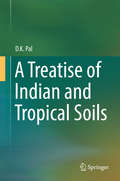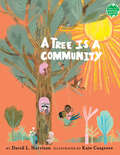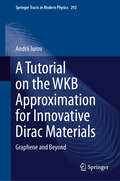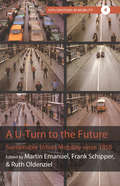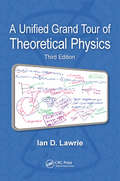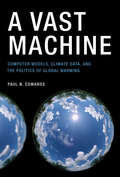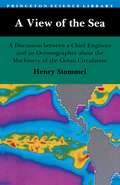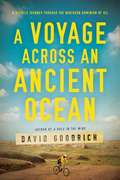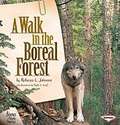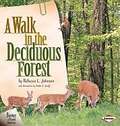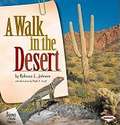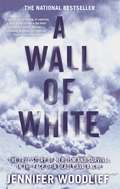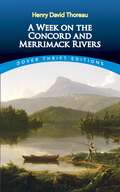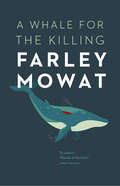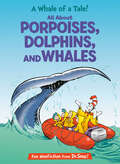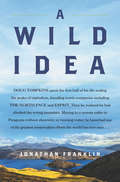- Table View
- List View
A Treatise of Indian and Tropical Soils
by D. K. PalThis book discusses how to apply the basic principles of pedology to the tropical soils of the Indian subcontinent, with an emphasis on ways to enhance crop productivity. The book showcases the research contributions on pedology, geomorphology, mineralogy, micromorphology and climate change collected from the literature on three major soil types: shrink-swell soils, red ferruginous (RF) soils and the soils that occur in the tropical environments of the Indo-Gangetic Plains (IGP). It also provides insights into several aspects of five pedogenetically important soil orders like Alfisols, Mollisols, Ultisols, Vertisols and Inceptisols found in tropical Indian environments. Documenting the significance of minerals in soils and their overall influence in soil science in terms of pedology, paleopedology, polygenesis and edaphology, it provides a knowledge base that is critical when attempting to bridge the gap between food production and population growth.
A Tree Is a Community (Books for a Better Earth)
by David L. HarrisonOne tree supports an ecosystem of life–insects, mammals, and even humans. Discover the surprising biodiversity of trees in this science picture book from award-winning creators of And the Bullfrogs Sing and The Dirt Book.A tree is more than just a plant, but a whole ecosystem hiding in plain sight, on street corners and in backyards everywhere. Discover how one tree provides shelter, food, and clean air to a host of animals and insects. Robins build their nest in the branches and bees gather nectar from flowers. The tree keeps its neighborhood clean, healthy, and safe. Leaves clean the air and roots keep the dirt from washing away. The tree&’s residents are safe through thunderstorms and changing seasons. This home is built to last!Those buds POP openand bees BUZZand rain SPLASHESand sun SIZZLESAuthor David L. Harrison&’s lively, rhythmic text informs and excites readers about the ecosystem of trees. Illustrator Kate Cosgrove&’s lush and dynamic illustrations color a charming world aglow with life. This award-winning team, from And the Bullfrogs Sing and The Dirt Book, are back with another picture book that invites young readers into the natural world around them. A Tree Is a Community is perfect for the budding naturalist. The Books for a Better Earth™ collection is designed to inspire young people to become active, knowledgeable participants in caring for the planet they live on. Focusing on solutions to climate change challenges and human environmental impacts, the collection looks at how scientists, activists, and young leaders are working to safeguard Earth&’s future.
A Tutorial on the WKB Approximation for Innovative Dirac Materials: Graphene and Beyond (Springer Tracts in Modern Physics #292)
by Andrii IurovThis textbook serves to supplement existing quantum mechanics courses with the WKB (Wentzel–Kramers–Brillouin) theory for recently discovered Dirac materials, such as graphene, a dice lattice, and alpha-T3 materials. This includes finding the semiclassical wave function, coordinate-dependent momentum, semiclassical action, the complete set of transport equations, and applicability conditions for the approximation. The discovery of graphene and its unique electronic behavior has transformed research in condensed matter physics over the last 10-15 years, but core curriculum in standard graduate-level physics courses still does not reflect these new developments and this book intends to close this gap. With a clear focus on various types of Dirac Hamiltonians, the multidimensional theory is only a small part of the book. The derivation of the WKB equations for novel Dirac materials and their applications to electron tunneling, turning points and classically forbidden regions, resonances and localized states, and many other crucial physical problems are methodically presented. This textbook aims to expand the existing approach to presenting the WKB approximation and covers recent developments in its applications. This book also includes many informative graphics, as well as problems and exercises with hints at the end of each chapter. Additional detailed mathematical derivations, as well as code in Mathematica, are added throughout the whole book. Ideal for graduate students and researchers in condensed matter physics, this textbook serves as a modern guide for learning the WKB theory.
A U-Turn to the Future: Sustainable Urban Mobility since 1850 (Explorations in Mobility #4)
by Ruth Oldenziel Martin Emanuel Frank SchipperFrom local bike-sharing initiatives to overhauls of transport infrastructure, mobility is one of the most important areas in which modern cities are trying to realize a more sustainable future. Yet even as politicians and planners look ahead, there remain critical insights to be gleaned from the history of urban mobility and the unsustainable practices that still impact our everyday lives. United by their pursuit of a “usable past,” the studies in this interdisciplinary collection consider the ecological, social, and economic aspects of urban mobility, showing how historical inquiry can make both conceptual and practical contributions to the projects of sustainability and urban renewal.
A Unified Grand Tour of Theoretical Physics
by Ian D. LawrieA Unified Grand Tour of Theoretical Physics invites its readers to a guided exploration of the theoretical ideas that shape our contemporary understanding of the physical world at the fundamental level. Its central themes, comprising space-time geometry and the general relativistic account of gravity, quantum field theory and the gauge theories of
A United Kingdom?: Economic, Social and Political Geographies
by John MohanThe human geography of the UK is currently being reshaped by a number of forces - such as globalisation, transition in the organisations of production, the changing character of state intervention, and changing relationships with Europe. A consideration of the impacts of these forces on economic, social and political landscapes is, therefore, an urgent task. At the same time, enduring institutional features of the British economy and polity are also having important influences on socio-economic processes. The result is a complex mosaic of uneven development, which belies the notion of simplistic regional contrasts.Rather than simply mapping spatial inequality, 'A United Kingdom?' charts the processes underpinning uneven development at a range of scales and for a number of key topics. The book draws upon and synthesises the latest contemporary research findings and places emphasis on the interrelated nature of economic, social and political geographies. It treats the human geographies of the UK in a coherent and integrated way, and asks whether contemporary processes of change are tending towards the reduction of socio-spatial divisions or their reproduction in new forms.
A Vast Machine: Computer Models, Climate Data, and the Politics of Global Warming (Infrastructures)
by Paul N. EdwardsThe science behind global warming, and its history: how scientists learned to understand the atmosphere, to measure it, to trace its past, and to model its future.Global warming skeptics often fall back on the argument that the scientific case for global warming is all model predictions, nothing but simulation; they warn us that we need to wait for real data, “sound science.” In A Vast Machine Paul Edwards has news for these skeptics: without models, there are no data. Today, no collection of signals or observations—even from satellites, which can “see” the whole planet with a single instrument—becomes global in time and space without passing through a series of data models. Everything we know about the world's climate we know through models. Edwards offers an engaging and innovative history of how scientists learned to understand the atmosphere—to measure it, trace its past, and model its future.
A View of the Sea: A Discussion between a Chief Engineer and an Oceanographer about the Machinery of the Ocean Circulation
by Henry M. StommelThe description for this book, A View of the Sea: A Discussion between a Chief Engineer and an Oceanographer about the Machinery of the Ocean Circulation, will be forthcoming.
A Vision For The National Weather Service: Road Map For The Future
by Panel on the Road Map for the Future National Weather ServiceA report on A Vision For The National Weather Service
A Visit to the Recycling Center
by Tracy Vonder BrinkTravel through Rumpke’s recycling center to find a plastic jug? Trash that can be recycled takes a ride on the conveyor belt to become something new! Try to find the milk jug on the conveyor belt! Trash at the factory goes through many machines to make sure it can be recycled. Can you guess what the milk jug will help make once it leaves the factory? What other types of trash go on the conveyor belt?
A Visual Atlas for Soil Micromorphologists
by Eric P. Verrecchia Luca TrombinoThis open access atlas is an up-to-date visual resource on the features and structures observed in soil thin sections, i.e. soil micromorphology. The book addresses the growing interest in soil micromorphology in the fields of soil science, earth science, archaeology and forensic science, and serves as a reference tool for researchers and students for fast learning and intuitive feature and structure recognition. The book is divided into six parts and contains hundreds of images and photomicrographs. Part one is devoted to the way to sample properly soils, the method of preparation of thin sections, the main tool of soil micromorphology (the microscope), and the approach of soil micromorphology as a scientific method. Part two focuses on the organisation of soil fragments and presents the concept of fabric. Part three addresses the basic components, e.g. rocks, minerals, organic compounds and anthropogenic features. Part four lists all the various types of pedogenic features observed in a soil, i.e. the imprint of pedogenesis. Part five gives interpretations of features associated with the main processes at work in soils and paleosols. Part six presents a view of what the future of soil micromorphology could be. Finally, the last part consists of the index and annexes, including the list of mineral formulas. This atlas will be of interest to researchers, academics, and students, who will find it a convenient tool for the self-teaching of soil micromorphology by using comparative photographs.
A Voyage Across an Ancient Ocean: A Bicycle Journey Through the Northern Dominion of Oil
by David GoodrichIn the face of widespread misinformation and misunderstanding, a climate scientist ventures into the vast heart of America&’s new oil country on just two wheels.Recently recovered from his epic bicycle journey that took him from the Delaware shore to the Oregon coast, distinguished climate scientist David Goodrich sets out on his bike again to traverse the Western Interior Seaway—an ancient ocean that once spread across half of North America. When the waters cleared a geologic age ago, what was left behind was vast, flat prairie, otherworldly rock formations, and oil shale deposits. As Goodrich journeys through the Badlands and Theodore Roosevelt National Park and across the prairies of the upper Midwest and Canada, we get a raw and ground-level view of where the tar sands and oil reserves are being opened up at an incredible and unprecedented pace. Extraordinary and unregulated, this &“black goldrush&” is boom and bust in every sense. In a manner reminiscent of John McPhee and Rachel Carson, combined with Goodrich&’s wry self-deprecation and scientific expertise, A Voyage Across an Ancient Ocean is a galvanizing and adventure-filled read that gets to the heart of drilling on our continent.
A Walk In The Boreal Forest
by Rebecca L. JohnsonTake a walk in the boreal forest. This biome of tall conifer trees and shaded, cool paths has long winters and very short summers. How do the plants and animals of the boreal forest live? Take a tour of this amazing biome and find out for yourself how each creature depends on all the others for survival.
A Walk In The Deciduous Forest
by Rebecca L. JohnsonTake a walk in the deciduous forest. In this biome of leafy trees and fast changing weather, there are four very different seasons. As you walk through this incredible biome, discover how all living things form a community and depend on each other for survival.
A Walk In The Desert
by Rebecca L. JohnsonTake a walk through the desert. This hot, dry biome of the southwest is full of life. How do plants and animals of the desert live? As you wander through the desert, discover how each and every plant and animal relies on the others to live and grow.
A Walk in the Woods: Rediscovering America on the Appalachian Trail (Bryson Ser. #8)
by Bill BrysonNEW YORK TIMES BESTSELLER • The classic chronicle of a &“terribly misguided and terribly funny&” (The Washington Post) hike of the Appalachian Trail, from the author of A Short History of Nearly Everything and The Body &“The best way of escaping into nature.&”—The New York Times Back in America after twenty years in Britain, Bill Bryson decided to reacquaint himself with his native country by walking the 2,100-mile Appalachian Trail, which stretches from Georgia to Maine. The AT offers an astonishing landscape of silent forests and sparkling lakes—and to a writer with the comic genius of Bill Bryson, it also provides endless opportunities to witness the majestic silliness of his fellow human beings. For a start there&’s the gloriously out-of-shape Stephen Katz, a buddy from Iowa along for the walk. But A Walk in the Woods is more than just a laugh-out-loud hike. Bryson&’s acute eye is a wise witness to this beautiful but fragile trail, and as he tells its fascinating history, he makes a moving plea for the conservation of America&’s last great wilderness. An adventure, a comedy, and a celebration, A Walk in the Woods is a modern classic of travel literature. NOW A MAJOR MOTION PICTURE
A Walk: Stoplight Secrets, Mischievous Squirrels, Manhole Mysteries & Other Stuff You See Every Day (And Know Nothing About)
by Spike Carlsen“Carlsen sees a world of wonder hiding in plain sight and may just change how you look at the world around you.” - TODAY ShowA simple walk around the block set journalist Spike Carlsen, bestselling author of A Splintered History of Wood, off to investigate everything he could about everything we take for granted in our normal life—from manhole covers and recycling bins to bike lanes and stoplights.In this celebration of the seemingly mundane, Carlsen opens our eyes to the engineering marvels, human stories, and natural wonders right outside our front door. He guides us through the surprising allure of sewers, the intricacies of power plants, the extraordinary path of an everyday letter, and the genius of recycling centers—all the while revealing that this awesome world isn’t just a spectator sport.Engaging as it is endearing, A Walk Around the Block will change the way you see things in your everyday life. Join Carlsen as he strolls through the trash museum of New York City, explores the quirky world of squirrels, pigeons, and roadkill, and shows us how understanding stoplights, bike lanes, and fine art of walking can add years to our lives. In the end, he brings a sense of wonder into your average walk around the block, wherever you are. Guaranteed.
A Wall of White: The True Story of Heroism and Survival in the Face of a Deadly Avalanche
by Jennifer WoodliefOne of the most amazing survival stories ever told -- journalist Jennifer Woodlief's gripping account of the deadliest ski-area avalanche in North American history and the woman who survived in the face of incalculable odds.
A Warmer World
by Caroline Arnold Jamie HoganAdapt, or face extinction. The golden toad used to inhabit the cloud forests of Costa Rica, but when the weather became too warm and dried up the pools where its eggs hatched, the golden toad disappeared. It has not been seen in more than twenty years. This amphibian is just one of several species in A WARMER WORLD, a thought-provoking and informative account of how global climate change has affected wildlife over the past several decades. Species by species, acclaimed nonfiction children's author Caroline Arnold describes how warmer weather alters ecosystems, forcing animals to adapt or become extinct. Arnold's clear and straightforward text is complemented by Jamie Hogan's collage-style illustrations. Reminiscent of a nature journal, the book will inspire readers to start their own research into this significant global issue. A glossary and listing of websites and books for further exploration is included.
A Week on the Concord and Merrimack Rivers (Dover Thrift Editions)
by Henry David ThoreauBased on an 1839 boat trip Thoreau took with his brother from Concord, Massachusetts, to Concord, New Hampshire, and back, this classic of American literature is not only a vivid narrative of that journey, it is also a collection of thought-provoking observations on such diverse topics as poetry, literature and philosophy, Native American and Puritan histories of New England, friendship, sacred Eastern writings, traditional Christianity, and much more.Written, like Walden, while Thoreau lived at Walden Pond, and published in 1849, A Week (his first book) shares many themes with Walden, published in 1854. Both dramatize the process of self-renewal in nature and resolutely rail against the official culture and politics of the "trivial Nineteenth Century." Blending keen observation with a wealth of perceptive and informed reflections, Thoreau develops a continuous and lyrical dialogue between the past and present, as particular scenes on shore trigger reflections on the region's history and legends.Originally conceived as a travel book, A Week eventually became much more -- one of the most intellectually ambitious works of 19th-century America, and a requiem for Thoreau's brother John, who died from a sudden illness in 1842.Of Thoreau and this work, Ralph Waldo Emerson said, "H. D. Thoreau is a great man in Concord, a man of original genius and character. . . . I think it [A Week. . .] is a book of wonderful merit, which is to go far and last long."
A Whale for the Killing
by Farley MowatWhen an 80-ton Fin Whale became trapped in a lagoon near his Newfoundland home, Farley Mowat rejoiced: here was a unique chance to observe one of the world's most magnificent creatures up close. But some of his neighbours saw a different opportunity altogether: in a prolonged fit of violence, they blasted the whale with rifle fire, and scarred its back with motorboat propellers. Mowat appealed desperately to the police, to marine biologists, finally to the Canadian press. But it was too late. Mowat's poignant and compelling story is an eloquent argument for the end of the whale hunt, and the rediscovery of the empathy that makes us human.
A Whale of a Tale! All About Porpoises, Dolphins, and Whales: All About Porpoises, Dolphins, and Whales (The Cat in the Hat's Learning Library)
by Bonnie WorthLaugh and learn with fun facts about whales, porpoises, dolphins, and more—all told in Dr. Seuss&’s beloved rhyming style and starring the Cat in the Hat! &“What&’s the story today? Funny that you should ask. We&’re going to take on a whale of a task!&” The Cat in the Hat&’s Learning Library series combines beloved characters, engaging rhymes, and Seussian illustrations to introduce children to non-fiction topics from the real world! Go under the sea and discover: • what a cetacean is• how to tell dolphins and porpoises apart• how whales &“talk&” to one another• and much more! Perfect for story time and for the youngest readers, A Whale of a Tale! All About Porpoises, Dolphins, and Whales also includes an index, glossary, and suggestions for further learning. Look for more books in the Cat in the Hat&’s Learning Library series!If I Ran the Horse Show: All About HorsesClam-I-Am! All About the BeachMiles and Miles of Reptiles: All About ReptilesSafari, So Good! All About African WildlifeThere's a Map on My Lap! All About MapsOh, the Lavas That Flow! All About VolcanoesOut of Sight Till Tonight! All About Nocturnal AnimalsWhat Cat Is That? All About CatsOnce upon a Mastodon: All About Prehistoric MammalsOh Say Can You Say What's the Weather Today? All About WeatherThe Cat on the Mat: All About Mindfulness
A Wild Idea
by Jonathan FranklinWHY WOULD A SAN FRANCISCO ENTREPRENEUR SELL HIS COMPANY, FLY TO THE ENDS OF THE EARTH, INVEST MILLIONS RESTORING PARADISE, THEN FIGHT LIKE HELL TO GIVE IT ALL AWAY? In 1991, Doug Tompkins left his luxury life in San Francisco and flew 6,500 miles south to a shack in Patagonia that his friends nicknamed Hobbit House. Mounted on wooden skids that allowed oxen to drag it through the cow fields, Hobbit House had for refrigerator a metal box chilled from the icy cold winds off the glacier. Rainwater dripped from a rooftop barrel into the rustic kitchen. Earlier tenants include a sheepherder with little more than his dogs and a rifle. Instead of the Golden Gate Bridge, Tompkins now stared at Volcano Michinmahuida, blanketed in snow and prowled by mountain lions the size of small tigers. Shielded by wilderness, waterfalls and tucked into a remote forest with three times the rainfall of Seattle, Tompkins plotted his counterattack against corporate capitalism. As founder of Esprit and The North Face he had “made things nobody needed.” Now he declared it was time to “pay my rent for living on this planet.” Could he undo the environmental damage produced by his prodigious clothes manufacturing? Could he launch a new brand, one that promoted environmental conservation, preservation and restoration? In Patagonia, Tompkins adored his pioneer existence. All his belongings fit in a single duffel bag. When hungry, he fished from his front yard and harvested vegetables from a greenhouse. Tompkins kayaked along the rivers, ice-climbed glaciers, and waited until the ocean storms reached a frothy peak to pilot his wood-hulled crab boat into the raging waves of the Pacific. Within a hundred miles there were virtually no roads and his old farm was accessible to the occasional fishing boat and a battered airstrip. Flying his small plane for hundreds of hours, he explored. The average plot of land is 10,000 acres and the price per acre is as little as US$25. It was all for sale and about to be destroyed by clearcut logging. Zooming over treetops and around mountain peaks, Tompkins flew inside tight canyons and gaped at the singular beauty: active volcanoes, gliding condors, forests never logged, rivers never dammed—all so undisturbed, so exquisitely designed, without a single flaw. Could he protect this wild beauty? Place a frame around this perfect creation? For the ensuing quarter century that dream, that obsession became his life. Only in death did it become his legacy.
